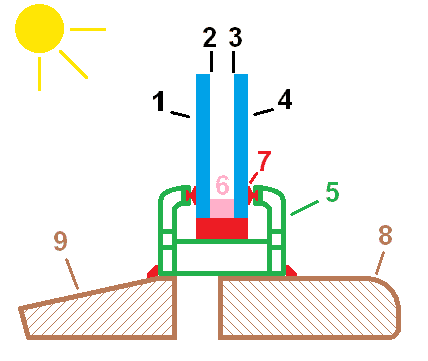5 Types of Energy Storage Explained
Types of energy storage are; electrochemical, thermal, mechanical, gas-liquid, and magnetic energy storage.
This article discusses the types of energy storage, as follows;
1). Electrochemical Energy Storage (as one of the Types of Energy Storage)
Electrochemical energy storage, as the name implies, is concerned with the use of batteries to store energy.
Most types of batteries used for energy storage are electrochemical cells [5]. This includes lithium-ion, lead acid, and flow batteries.
In order for energy to undergo electrochemical storage, it must first be converted to chemical energy. It is fairly common for this conversion to involve a direct transformation of electricity to chemical energy through come chemical reactions, hence the name ‘electrochemical’ [4].
The energy is then stored in an electrolyte, and may be recovered through a second conversion from chemical energy to a more usable form, such as electric power. This is what leads to the discharge of electrochemical batteries as their stored energy is released.
The effectiveness and reliability of electrochemical energy storage both depend on the energy efficiency of the battery involved. Depth of discharge (DoD) is another important quantity that determines the performance of batteries in electrochemical energy storage [2].
2). Thermal Energy Storage
Thermal energy storage (TES), as the name implies, is a type of energy storage that directly depends on heat flow or heat differences, for its operation.
It is generally based on the conservation of energy in the form of heat or cold, which is released and used subsequently. In most cases, the stored heat or cold is used in a different system or environment, and at a different time.
The goal and importance of thermal energy storage both arise from its ability to reduce the amount of waste energy that is lost from a system or body, through active energy conservation [3].
Thermal energy storage is versatile in its relevance. It may be applied with electric generators, large power plants, cogeneration facilities, renewable energy systems, and water conservation equipment.
The main requirement for thermal energy storage is any absorptive, conductive, and retentive material. All materials having all three qualities can be used as TES systems.
For example, thermal energy storage can be achieved using water as a storage medium [6]. Here, waste heat is discharged into water reserves, which may retain, and transfer this heat, under the right conditions.
Mechanisms involved in thermal energy storage include conduction and radiation. Convection may also be involved, but rarely plays any major role.
These mechanisms are what enable heat energy to be transferred into and out of the storage system.
Thermal energy storage is relatively simple, and often sustainable. It creates avenue for recycling of energy, and could be configured to operate in a cyclic and self-sufficient manner, especially in large technological systems like nuclear power plants.
One of the most common practical applications of thermal energy storage is building heating and cooling.

3). Mechanical Energy Storage (as one of the Types of Energy Storage)
Mechanical energy storage (MES) exploits the dynamics of kinetic motion and gravity, to store energy in isolated systems [9].
The energy is usually converted to hydrodynamic or thermodynamic form in order to store it, and may occur as compressive or kinetic force, in the mechanical storage system.
Mechanical energy storage is possible in systems that operate by, and are equipped with kinetic and hydrodynamic components like pumps, turbines and compressors. These components help convert the energy into a storable form.
The relevance of mechanical energy storage is based on the role which mechanical energy plays in several methods of electricity generation, and in several power systems like wind turbines, hydroelectric plants, wave power converters, fossil fuel plants, and geothermal facilities.
These systems all rely on mechanical and kinetic processes to convert energy to its usable form.
Mechanical energy storage systems may operate through air compression, where energy is stored as hydrodynamic force in a pressurized fluid. Examples of this approach include liquid air energy storage (LAES) and compressed air energy storage (CAES) [8].
Other examples of MES systems include flywheel and pumped hydrological systems.

4). Gas-Liquid Energy Storage
Gas-liquid energy storage can also be referred to as hydrogen energy storage.
It is based on the relevance of liquid hydrogen as an energy source, and the process(s) involved in producing this source of energy.
In hydrogen energy storage, energy in the form of electric power, is stored when it is used to produce liquid hydrogen.
The process of liquid hydrogen production itself is energy-intensive, involving electrolysis, cryogenic conversion and compression [1].
According to the analogy behind hydrogen energy storage, energy that is used in any of these stages of the process of liquid hydrogen production, is said to be stored in the fuel which is produced.
Therefore, the use of liquid hydrogen as a fuel in spacecrafts or hybrid vehicles, can be described as the discharge and subsequent use of this stored energy.
Hydrogen energy storage has facilitated the advancement of hydrogen as an alternative energy resource, as well as the development of hydrogen-based technologies such as the hydrogen fuel cell.
5). Magnetic Energy Storage (as one of the Types of Energy Storage)
Magnetic energy storage is a type of energy storage which uses the principle of electromagnetic induction to convert and store kinetic energy in the form of electric charges.
This principle is identical to what is used to generate electricity in electric generators, and to produce kinetic motion in electric motors.
It is also known as ‘Superconducting Magnetic Energy Storage (SMES), due to its dependence on superconducting materials as a storage and transmission medium [7].
In magnetic energy storage, energy in the form of electricity, is stored in a superconducting coil, through which flows continuously in a magnetic field.
The success of this approach is based on the maintenance of a state of equilibrium between magnetic and electrical fields in a closed system. Energy remains stored in the superconductor for as long as the magnetic field is sustained.
Because the magnetic field is also dependent on the electric field for its sustenance, the setup is usually effective.
However, the efficiency of magnetic energy storage depends on various factors including the strength of the fields, nature of materials, and degree of isolation from the external environment.
Conclusion
Types of energy storage are;
1. Electrochemical Energy Storage
2. Thermal Energy Storage
3. Mechanical Energy Storage
4. Gas-liquid Energy Storage
5. Magnetic Energy Storage
References
1). Aziz, M. (2021). “Liquid Hydrogen: A Review on Liquefaction, Storage, Transportation, and Safety.” Energies 14(18):5917. Available at: https://doi.org/10.3390/en14185917. (Accessed 31 October 2022).
2). Barua, S.; Pathan, A. H.; Siddiki, M. R.; Hassan, I. (2009). “Performance Analysis of Industrial Battery.” Available at: https://doi.org/10.13140/RG.2.1.1944.1521. (Accessed 31 October 2022).
3). Dincer, I. (2002). “Thermal energy storage systems as a key technology in energy conservation.” International Journal of Energy Research 26(7):567 – 588. Available at: https://doi.org/10.1002/er.805. (Accessed 31 October 2022).
4). Gupta, R.; Nigam, N.; Gupta, A. (2011). “Application of energy storage devices in power systems.” International Journal of Engineering Science and Technology 3(1). Available at: https://doi.org/10.4314/ijest.v3i1.67656. (Accessed 31 October 2022).
5). Krivik, P.; Baca, P. (2013). “Electrochemical Energy Storage.” In (Ed.), Energy Storage – Technologies and Applications. IntechOpen. Available at: https://doi.org/10.5772/52222. (Accessed 31 October 2022).
6). Liang, F.; Zhang, Y.; Liu, Q.; Jin, Z.; Zhao, X.; Long, E. (2017). “Experimental Study on Thermal Energy Storage Performance of Water Tank with Phase Change Materials in Solar Heating System.” Procedia Engineering 205:3027-3034. Available at: https://doi.org/10.1016/j.proeng.2017.10.257. (Accessed 31 October 2022).
7). Padimiti, D.; Chowdhury, B. (2007). “Superconducting Magnetic Energy Storage System (SMES) for Improved Dynamic System Performance.” Power Engineering Society General Meeting, 2007. IEEE. Available at: https://doi.org/10.1109/PES.2007.385739. (Accessed 31 October 2022).
8). Rajabdorri, M.; Sigrist, L.; Lobato, E. (2022). “Liquid Air Energy Storage Model for Scheduling Purposes in Island Power Systems.” Energies 15(19):6958. Available at: https://doi.org/10.3390/en15196958. (Accessed 31 October 2022).
9). Wensel, T.; Lu, Z.; Chen, W.; Han, M.; Zhao, G.; Wang, X.; Deng, Z. (2022). “Solid Gravity Energy Storage: A review.” The Journal of Energy Storage 53. Available at: https://doi.org/10.1016/j.est.2022.105226. (Accessed 31 October 2022).


